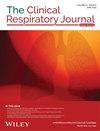Anlotinib is widely used in the treatment of lung cancer. However, there remains a lack of predictive biomarkers to effectively gauge the response to anlotinib therapy. We conducted a retrospective study to preliminarily explore potential risk factors that might predict outcomes in lung cancer patients undergoing anlotinib treatment.
We retrospectively analyzed lung cancer patients treated with anlotinib at our hospital between 1 June 2018 and 1 June 2021. Data were gathered from electronic medical records. Demographic and clinical characteristics of patients, progression-free survival (PFS), and overall survival (OS) were described. Predictive factors related to treatment efficacy were preliminarily analyzed using Cox regression and Kaplan–Meier survival analyses.
After adjusting for potential confounders, clinical stage IV (hazard ratio [HR] = 2.52, 95% confidence interval [CI], 1.09–5.82, p = 0.0311), N-terminal fragment brain natriuretic peptides (NT-pro-BNP) > 300 pg/mL (HR = 2.54, 95% CI, 1.17–5.52, p = 0.0183), and neuron-specific enolase (NSE) > 16.3 ng/mL (HR = 1.70, 95% CI, 1.03–2.81, p = 0.0389) were associated with shorter OS, whereas age (HR = 0.96, 95% CI, 0.94–0.99, p = 0.0055) was associated with a longer PFS in fully adjusted model. Kaplan–Meier analyses of cumulative risk factors (clinical stage IV, NT-pro-BNP > 300 pg/mL, and NSE > 16.3 ng/mL) indicated that patients with a greater number of coexisting risk factors had significantly shorter OS (p < 0.0001).
Clinical stage IV, NT-pro-BNP level, and NSE level were identified as independent prognostic factors for lung cancer patients undergoing anlotinib treatment. Patients with multiple high-risk factors may derive limited benefit from anlotinib.



